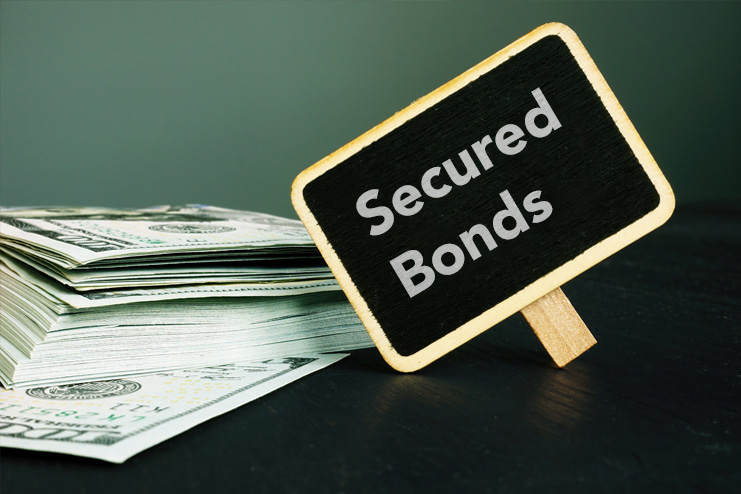What Is a Secured Bond? A Guide for Investors
A secured bond is a debt security backed by an asset (such as real estate, physical assets, or a defined revenue stream) that provides protection against default. If the bond issuer doesn’t repay the principal along with interest, investors have the first claim on the asset securing the loan.
Secured bonds:
- Offer defined interest and principal repayment terms
- Use assets as collateral
- Lower borrowing costs for issuers
This post walks step by step through what secured bonds are, how they work, and what happens if the bond issuer defaults on the bond.
Secured bonds in depth
Bonds, in general, represent a type of loan investors extend to corporations, governments, or other entities. In return for the principal lent, the bond issuer usually agrees to a schedule of periodic interest payments, known as coupons, to the bondholder. At the bond’s maturity date, the issuer repays the principal.
Difference between secured bonds and unsecured bonds
Bond issuers like corporations or governments raise capital through either secured or unsecured bonds. Here are notable differences between these types of bonds:
- Asset backing. Secured bonds are directly collateralized by a specific asset that can be transferred to investors in the event of a default. Unsecured bonds have no specific collateral, which means repayment depends on the issuer’s financial health.
- Credit risk. For similar issuers, secured bonds tend to have better perceived repayment ability than unsecured bonds. This reflects lower credit risk because the bondholder has a higher chance of recovering funds in bankruptcy.
- Interest rate. Due to lower credit risk and the presence of collateral, secured bonds may offer lower interest rates than unsecured bonds and be less sensitive to market interest rates. Given that investment-grade bonds are yielding around 4.68% as of Mar 15, 2023, secured investment-grade bonds would likely yield less than that.
How do secured bonds work?
To safeguard bondholder interests, the issuer provides collateral to secure the bond. If the issuer defaults and can’t pay the bond interest and principal, the collateral can be sold to help recover the bond investment. Legally, bondholders are secured creditors, which means they get the first senior claim on the collateral.
Collateral may be either tangible or intangible assets. Assets commonly used as collateral for secured bonds include:
- Real estate
- Manufacturing plants
- Industrial equipment
- Revenue streams
- Intellectual property
- Inventory
- Financial assets such as stocks and bonds
Securing bonds with collateral helps to lower default risk, allowing issuers to obtain financing at lower interest rates.
Interest rates paid on secured bonds vary depending on:
- Credit quality. The credit quality reflects the ability of the issuer to repay the bond and the security of the collateral. Credit rating agencies, such as Standard & Poor’s, Moody’s, or Fitch Ratings, assign ratings to bonds that reflect their creditworthiness.
- Time to maturity. Rates vary depending on the duration of the investment.
- Market interest rates. Issuers determine rates relative to the general cost of borrowing in the market.
Reasons to invest
A balanced investment portfolio usually consists of a mix of stocks and bonds. Including secured bonds in a balanced strategy has the following benefits:
- Diversification. Secured bonds can add a relatively lower risk profile that gives a portfolio a more conservative approach.
- Capital structure priority. While all bondholders generally have a claim on issuer assets in the event of default, the priority depends on the seniority of the claim. Issuers pledge specific assets as collateral for the bond, which provides a layer of protection for investor capital.
- Income stream. Secured bonds generate yield for investors.
How to invest in secured bonds
If you’re interested in investing in secured bonds, you can start with the following steps:
- Open a brokerage account. A brokerage account allows you to buy and sell bonds. A broker would facilitate bond purchases in the secondary market and not directly from the issuer.
- Do your research. Consider your risk profile and investment goals to determine which secured bonds may suit your portfolio. You may want to consult a financial advisor to help you review credit ratings, interest rates, repayment terms, and the quality of collateral.
- Place an order. Gather all relevant information about the bond — the name of the issuer, the bond symbol, and the number of bonds you want to buy (or capital you wish to invest) — to buy the bond through your brokerage. Most bonds have minimum size requirements you will need to exceed.
Common issuers and types of secured bonds
Secured bonds are commonly issued by corporations, government agencies, and municipalities. The goal is to raise capital for projects such as building infrastructure, purchasing new equipment, repaying other debt, or funding ongoing operations and expansion.
Mortgage bonds
A mortgage bond is backed by a pool of mortgage loans and issued by government agencies such as Fannie Mae and Freddie Mac to finance mortgage lending. Payments made by homeowners on their mortgages fund interest payments on mortgage bonds.
Secured corporate bonds
Secured corporate bonds are issued by corporations and backed by collateral or assets such as inventory, property, patents, or equipment. The assets could be tangible assets such as property, inventory, or equipment, or intangible assets such as patents or trademarks.
Revenue bonds
State or local governments and their agencies issue municipal bonds to fund public projects such as building schools, hospitals, and other public facilities. Revenue bonds are municipal bonds backed by the revenue generated by a specific project, such as toll roads, bridges, or airports. These projects generate income, which is used to repay the bondholders, rather than the issuer’s general tax revenue.
Asset-backed bonds
Asset-backed bonds are a form of asset-backed securities (ABS) collateralized by a pool of income-generating assets, such as loans, receivables, or royalties. A financial institution buys these assets, packages them into a portfolio, and sells them as bonds to investors. Cash flows from the assets pay bond interest and principal.
Issuer defaults
What is an issuer default?
An issuer default occurs during bankruptcy or when the issuer cannot meet its financial obligations to pay interest or repay the principal. Macroeconomic conditions like higher interest rates or entity-specific cash flow issues can trigger a default.
How often do issuer defaults happen?
Defaults are not particularly common. The frequency of issuer default depends on the type of security, the creditworthiness of the issuer, and prevailing economic conditions.
Between 1970 and 2000, the 10-year cumulative default rate for all investment-grade municipal bonds was 0.042%, compared to 0.6750% for investment-grade corporate bonds. Corporate default rates as of January 2023 for the lowest-grade speculative corporate debt was 2.8%. Secured bond defaults are likely to be lower.
How does an investor claim the asset in the case of a default?
The process to claim an asset may vary depending on the terms of the bond and applicable laws. In general, should an issuer default on a secured bond, creditors may initiate a legal process to either restructure the debt or sell the assets. The collateral backing the bond can be sold to repay bondholders, though the full outstanding principal and interest may not be recovered.
How does the risk compare to other common investment assets?
Secured bonds have the first priority claim on collateral, which reduces their risk compared to these common investment assets:
- Equities — Can generate higher returns than secured bonds but are more volatile and carry greater market risk
- Real estate equity — Offer stable cash flows and appreciation potential subject to economic and market conditions
- Futures and commodities — Often used as speculative or hedging instruments but can show significant price volatility
- Cryptocurrency — Highly volatile asset class with significant risks due to its lack of regulation and potential for fraudulent activity
The risk of secured bonds depends primarily on the collateral value, which impacts the recovery of capital. Before investing, investors need to carefully evaluate collateral and then monitor changes accordingly.
Quicken has made the material on this blog available for informational purposes only. Use of this website constitutes agreement to our Terms of Use and Privacy Policy. Quicken does not offer advisory or brokerage services, does not recommend the purchase or sale of any particular securities or other investments, and does not offer tax advice. For any such advice, please consult a professional.



